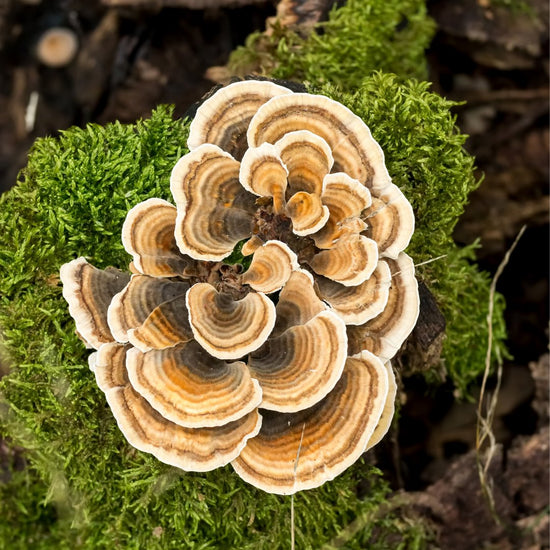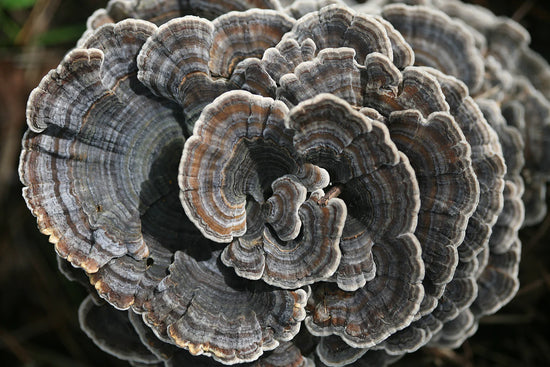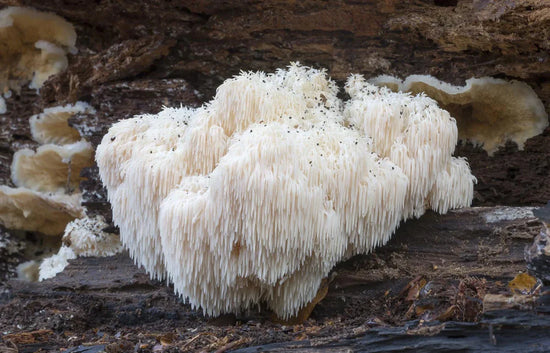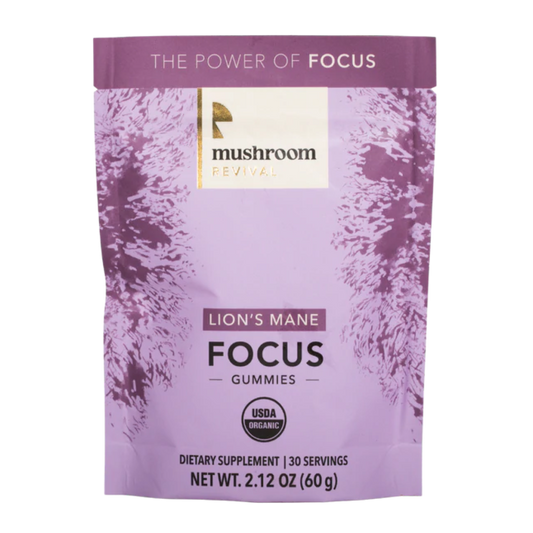Mycoviruses: Fungi Can Get Sick, Too
Today’s show covers a field known as mycovirology, or the study of viruses that infect fungi. This esoteric science is nascent but profound in its applications, and we are welcoming one of the few people in the world who are studying these relationships. Why do mycoviruses matter? How can we work with and against them? How can this subfield influence mycology as a whole?
We welcome Dr. Brenda Wingfield from the university of Pretoria in South Africa. Brenda holds her degree in fungal genomics and has published over 300 respective articles. Her work has expanded the mycological fields of taxonomy, phylogeny, ecology and tree pathology.

Topics Covered:
- Defining mycovirology
- What makes fungal viruses unique from others
- Stuck fermentation caused by killer yeasts
- Asymptomatic vs symptomatic viruses
- Mechanisms of viral infection in fungi
- Using mycoviruses to combat Chestnut Blight
- Viruses transferring from plants to fungi
- Armillaria viruses
- Genetic engineering with viruses
- What we know about the fungal immune system
- The detriment of La France disease in Agaricus bisporus farms
- 1000 Fungal Genome Project
Show notes:
Dr. Brenda Wingfield's publications:https://scholar.google.com/citations?user=tnLyuG0AAAAJ&hl=en
Five Questions about Mycoviruses: https://journals.plos.org/plospathogens/article?id=10.1371/journal.ppat.1005172
Mycoviruses educational video: https://www.youtube.com/watch?v=UXZBMcmGv84
Killer Yeasts in Wine: https://www.sciencedirect.com/science/article/abs/pii/0922338X9390056E
Secrets of Fungal Viruses: https://theconversation.com/researchers-unlock-the-secrets-of-fungal-viruses-why-it-matters-158632
Mycoviruses in Biological Control: https://apsjournals.apsnet.org/doi/full/10.1094/PHYTO-05-19-0166-RVW
TRANSCRIPT
You're listening to the mushroom revival podcast.
Lera 0:12
Today on the show, we're talking about fungal viruses or myco viruses, which are viruses that can infect fungi. Yes, you heard that right. fungi can get viral infections too.
Alex 0:23
So the next time you're out foraging for mushrooms and you see mushrooms popping up six feet apart, you might be getting a sneak peek into the lockdown habits of mushrooms. Jokes aside, we have one of the only people in the world to study this field known as myco, virology to enlighten our myco enthusiast listeners.
Brenda 0:42
My name is Brenda Wingfield. I'm an African I was born in Zambia grew up in Rhodesia Zimbabwe. I kind of studied genetics and biochemistry as a background and have ended up completing my my PhD on killer yeasts and killer use of saccharomyces servicio with viruses in them. So that kind of is my my quick summary. I'm currently a professor at the University of Pretoria, which is in Pretoria, South Africa.
Lera 1:20
And it's winter for you right now.
Unknown Speaker 1:21
So that's absolutely right. We're also doing a third wave of COVID-19. So viruses upper mind, and now, you know lives at the moment.
Lera 1:33
Indeed, it's a hot topic, Google Trends, viruses at an all time high. This is such a unique way of framing it you know, I never ever really thought about viruses and fungi. I've definitely considered that in animals and then further with plants, you know, having pathogens and stuff but in a fungus that seems to be the most foreign viral case. For me personally. So before we get into fungal sickness, how did you get into mycology? We're so curious about your story.
Brenda 2:06
Yeah, so as I've said, My classic training is in in biochemistry and genetics, but for my PhD, I worked on killer use. So killer use, actually, many things, but the killer use I was working on with saccharomyces servicio that are infected with a virus. And these killer yeasts kill other yeasts. And they can cause then stuck fermentations and I did my PhD in Stellenbosch, which is the center of our wine country. And stuck fermentations is not good for the wine industry, and you have to have money to do research. So that was my kind of venture into into mycology. And then after my PhD, I started to actually collaborate with my husband, who is a classically trained plant pathologist. And I mean, I'd been telling him for years that that DNA was where it all all is. And certainly when we first got married, the, the technologies weren't there. But But with time, we started to collaborate more. And one of the things we collaborated on is, is looking at some of the viruses in the fungi that are his particularly interested in he's interested in tree diseases, so particularly Eskimo seats that cause tree disease. And that's kind of how I guess launch launched my career doing doing mycology, viruses, genetics, and generally having a lot of fun.
Lera 3:39
So killer yeasts a quick aside on stuck fermentation since we imagine this might be a case of myco virus that directly impacts anyone out there who brews with the ever present saccharomyces service, ie a stuck fermentation, simply put, is when fermentation halts, and you are no longer getting alcohol and co2 from your brew despite there being available sugars to convert. Generally, what's said to be a fault here is excessively high temperatures a deficiency in essential nutrients like nitrogen, lack of oxygen, or some kind of contamination, but there may very well be another culprit that is unrelated to environmental conditions. Your yeast could be a killer yeast, which is caused by a double stranded RNA virus that causes secretion of toxins that kill cells of the same or related species.
Alex 4:27
Stuck fermentation caused by killer yeast are more likely to be an issue with wild or naturally found ferments like those used in wine and barley. So what can we do about it? Well, not much other than just starting over. And if wild ferments continue to be an issue, sourcing a starter culture from a trusted supplier should be enough measure to ensure you're not brewing with infected yeast. So fungi can get sick, which is pretty mind blowing for us. We're hearing about it. So they can get viruses they can get infection And more. What about cancer? You know, can can they get other illnesses and diseases that we humans also get? And are there other illnesses or diseases that fungi get that, say animals, plants, bacteria, other organisms cannot?
Brenda 5:18
will certainly, okay, so, so fungi can become infected with viruses. And, and remember, not only are the viruses necessarily cause a disease, they're not all necessarily symptomatic. And that's also true of viruses in, in plants and animals, not all viruses actually, you know, cause symptoms. And in actual fact, I'm arguably maybe more interested in the ones that, that don't cause symptoms. But in terms of, you know, can fungi get cancer, I suppose, in terms of the fact that, you know, cancers really are mutations, which allows cells to, to grow abnormally br, you know, fungi can get mutations that can make them grow abnormally. But fungi are kind of neat in the fact that they have these high fee and they can reproduce clonally. So they're not dependent on on just having, you know, one body one individual, which is the case, obviously, in case of humans, but fungi can kind of reproduce in many different ways. And in fact, that's one of my other interests is is the whole meeting system in fungi, which is also kind of cool. So yeah, fungi, fungi are part of biology. I know, my husband, has been known to say that fungi are just insects without legs.
Lera 6:44
I love that. And one follow up question. In the classical sense, fungi cannot get cancer, right? Just the idea of cells mutating uncontrollably. Oh, no, I think that can happen. Absolutely. Okay. Yeah. And the the entire fungus would be cancerous. It's not like a portion of the the filaments would be cancerous or how
Brenda 7:07
I think it would be just portions, you know, because I mean, what would happen is that you would get in remember, humans are very complex multicellular organisms, whereas largely speaking, fungi are very simple. So say, for instance, black happens in cancer, you would get a mutation in some gene that's controls replication, that means that then the fungus is growing unreasonably fast. So then you would have holida, fungal cells that would have the ability to grow really, really fast. But those cells wouldn't necessarily affect the rest of the mycelium. Because it would be quite localized. And you might kind of just get suddenly things going a little bit haywire. So I mean, I don't I don't think in terms of what a cancer cell looks like, I mean, a cancer cell is, is just a cell that has a mutation that's not really behaving like it's meant to be behaving.
Lera 8:06
So you talked about how fungi are basically one big clone. And that's so true. I mean, in the lab, if we wanted to clone a sheet hockey mushroom, I could take from any part of that, right, the, whether it's in the filamentous stage or the fruiting stage, and expect to get the same kind of genetics and strain.
Brenda 8:23
Yeah. But that they do, mutate. I mean, they, and I mean, it's quite well documented that with time, sometimes the cultural characteristics can degenerate and I, and I suppose that might be some kind of mutation, though, you know, many of these things haven't been well studied. So sometimes, the answer is we actually don't know the answer. Definitely.
Alex 8:47
So I didn't know that one could get a virus and not have symptoms or cause any harm. So I'm curious, the two different sides. If one got a quote unquote, bad virus, what are the symptoms that fungi would get? You know, humans get fever, lethargy, aching joints, diarrhea, vomiting, etc? What what happens with the fungi? And then on the flip side, you say there are viruses that don't cause harm or symptoms, what does that look like? And why are they there?
Brenda 9:22
Well, simplistically, the viruses that you can say maybe cause harm in in fungi that have been studied of viruses that cause the fungi to grow more slowly, or maybe not to be quite so very left if you're talking about fungi that are in actual fact, plant pathogens. So you can kind of say that the viruses just mess with the metabolism of the fungi, and they can't reproduce quite so fast, and they can't cause the disease and and, you know, the in terms of causing the death zees the, you know, the potential there is to be able to use these viruses for bio control of certain plant pathogens, in terms of the viruses that, that don't cause any problems or that don't have any apparent symptoms. That's one of the reasons I think why fungal viruses have been so overlooked, is, in the viral world, everybody's looking for something that actually does something. But a number of the fungal viruses that I've described, you know, the biologists say to me, Well, what does the virus do? And I'm going well, it replicates and the fungus and that doesn't seem to actually do anything. And you could maybe say that, that is the ultimate parasite doesn't kill its host. It's gonna be there forever.
Lera 10:46
Yeah, right. I mean, when I'm thinking about good virus versus bad, I presume that a bad one would be aggressively hijacking the nucleolus. And breaking apart that that DNA because it needs to replicate. But what a so called Good one, just do this at a slower rate and just keep propagating until there's a viable community living in the cytoplasm, but it doesn't really interfere with the funguses natural behaviors.
Brenda 11:14
Yeah, if you if you think about, I mean, one of the basic problems is, is we probably don't know enough about many of these fungal viruses. So you know, to label them good or bad is quite difficult. But quite often, when you you think of pathogens, that with time, they will actually move towards being more in some kind of symbiosis with the host. So that they don't kill the host, because it's actually not necessarily advantageous for a virus to kill its host, it's probably better for the virus to keep the host going. So, you know, viruses don't necessarily kill on or obviously detrimental. And, you know, and I know, people often talk to me, and they say, well, fungi are bad, I'm going well, you know, some fungi are good. And some fungi are not so good. It all depends on who you're talking to when what you're talking about,
Lera 12:17
to the viruses, I don't know, this might be another thing we just don't know yet. But do they tend to just remain inside of the fungus? Or do they eventually get out through them to creating metabolites or break through the cell wall somehow? What What have you observed? If anything,
Brenda 12:33
okay, so this is the one, the one thing that really does make most of the fungal viruses very different is, people have a tendency to think that all viruses are going to have coat proteins, and they're actually going to be spewed out of cells, and then they'll go orphan, but like what COVID-19 is doing, as you know, people aspirated into aerosols and in the virus is actually able to move that way. Now, in actual fact, not all viruses necessarily move in in the air or, or leave the host cells. In fact, there are a number of bacterial viruses that that never actually leave the host cells. But we've been we're not aware that there are any fungal viruses that ever leave the fungal cells. And in actual fact, a lot of the fungal viruses don't even seem to have a classic coat protein. So they don't necessarily form even viral like particles. In the fungal cells, they just seem to kind of sit there and replicate. How do they get transferred, food will, will fungi and do this thing called an Eskimo sets, which means that they can share cytoplasm, and in order to be it for a fungus to an Eskimo is it has to be the same vegetative compatibility group. And there's, there's quite a bit written about how fungi can recognize each other through this vegetative compatibility. Now, if you have one fungal strain, that has the virus, that then meets another fungal strain, that is the same compatibility group, the hyphy can meet and join, and the cytoplasm is then shared, and then the viruses shared so the the virus kind of sneaks in that way. Now, the whole vegetative compatibility groups is quite interesting, because you're most probably aware that the the fungi that cause rot in trees, quite often will form what is called spalted wood. And that's quite pretty. And one of the reasons that spalted wood is quite pretty is that you see the zone lines between the different fungi that are in the wood, and those zone lines are as the result of the fungi. Not being the same vegetative compatibility groups, so they then don't recognize each other. And what happens then is you get a form of programmed cell death. And those that don't lines, they know those dark lines that you see in the word. So this this compatibility and fungal then as to Moses, there's actually been quite a bit that's been done on that in terms of how fungi recognize each other. But the compatibility is within a species it's, you don't normally find fungi, recognizing, you know, different species that that compatibility but would be within the same species.
Lera 15:41
So I understand how a virus could transfer from one strain of a fungus to another, but how does it get in there in the first place as the spore germinating and then it just is really weak and susceptible, at some point,
Brenda 15:55
will, a lot of the, what what we understand is the that some of the spores contain the virus as well. And in actual fact, the one classic example is the La France disease, which is the disease of Agaricus Bosporus. Now, Garrick spot spores produces a lot of spores, the Cydia spores, and if the original strain of the fungus has the virus, that virus will actually be transferred to the bacillus spores as well. And whether the virus is transferred to the spores actually does depend on the virus. But the idea is that essentially, the viruses are there all the time, and are transmitted through spores or if they're not being transmitted through spores. They're transmitted through this anastomosis.
Lera 16:51
Love France disease. It essentially marks the birth of microbiology as a distinctive science. It was the first recorded case of a myco virus that had a significant impact on our lives. In the 1940s, Agaricus bisporus. That's the button mushroom portobello mushroom. Many of those farms are experiencing a number of hardships with their crops.
Alex 17:11
Scientists found three different viruses living in these fungi and it resulted in symptoms like reduced yields yellowed and atypical mycelial growth waterlogging in the fungal tissues, deformations, premature fruiting, and reduced shelf life, we all know how disruptive COVID-19 was for our lives. Now think of the same situation for fungi. Although they might not need mass or social distancing, there are still measures we can take to ensure that we can be free of viruses. And I wish it was as easy as installing an antivirus software on our mushroom farm. But unfortunately, john McAfee didn't get there yet. So in terms of fungi, and also humans, what are the fungi and you know, say these these Agaricus cultivators, what are they both doing to protect against these viruses that could be detrimental for their growth.
Brenda 18:14
As I understand it, the only thing that the cultivators have Gary has space for Boris can do to predict against infection is just to be really, really clean in terms of the cultivation. Because, you know, you could potentially actually get a spore just flying in from the outside, and that could have the virus. And I think this is actually quite a problem in virus cult culture, in virus cultivation in mushroom cultivation, that they have to be conscious on the constant lookout before any malformation of the mushrooms. And if if if they get it then they just have to I guess, you know, clean up that batch and and sterilize everything.
Alex 19:01
And that's an edible species and another edible variety that pretty much all humans eat almost every day is saccharomyces service ca which use you study pretty, pretty intensely, which it goes into brewing beer and baking bread and a ton of fermented foods and beverages that humans have loved for 1000s of years. What would happen if we ate a fungi that was infected with a virus could transfer onto us or make us sick in any way?
Brenda 19:36
Unlikely. I mean, the knee jerk kind of answer would be that if you if you ate bridge or for that matter drank beer or or I prefer to drink wine that happened to have some sacrifices service that was infected with a virus. It's unlikely that that anything would happen. I'm having said that. I mean, that's been the interesting thing. And one of the reasons why I've started to get maybe more excited about fungal viruses is, there's been quite a bit of suggestion now that we're starting to understand a little bit and understand we still, this is still really, really new stuff. But while we are starting to understand a little bit more about these fungal viruses, what some researchers have done in actual fact, it's a it's a Chinese group, who showed that Razak Tonia solani, which is a plant pathogen is an actual fact able to take up the cauliflower mosaic virus from plants that the rhizoctonia the fungus is infecting that that raz atonia can take up the virus from the plants, it can in actual fact, that Boris seems to be quite happy to replicate in the rasik tonja. And that the those researchers, what they're able to do is that they were able to then isolate the cauliflower mosaic virus from the rhizoctonia and reinfect the parts so it kind of seems as if that cauliflower mosaic virus was quite happy to live in in the fungus as well as to go back in into the plot. So the the one thing that we think might be happening with some of these fungi is that their mind in actual fact be taking up viruses from whatever they hosts are and that was one of the reasons that we started to talk about doing the work that we did on the on malaria viruses. So the the whole story behind the on malaria viruses was that I had a conversation with one of the other few people who actually work on on myco viruses. Jaco Angela, who is finish and Jaco had been doing some work on hatred, but the student knows them, which is not a fungus I normally work on because it's predominantly in the Northern Hemisphere. And he had some tentative evidence that it seemed that the hair triplicity on a no some isolettes he was working with, contains some of these 300 was against a tree fungus contains some of these tree viruses. And Jaco was leaving us he said to me would be quite neat to maybe look at all malaria. And there's a there was a young researcher who now actually has has a faculty position in Finland. Ricker, Linda kostki wrote a grant to look at the our malaria viruses. And we have a particular the interesting situation in South Africa is that the early European settlers brought into Cape Town fruit trees, citrus trees, and in so doing, they deposited a clone a single clone of armillaria Melia. And I think if I've got it right, on malaria Melia is also known as the honey fungus. And people do do eat it. And it's rather a nasty pathogen. But through some of the work that we've been doing is we know that that on malaria Melia is a single clone, and it's been sitting in Cape Town for 300 years, it's been growing, getting bigger and bigger all the time. So you're currently I thought, well, that's kind of cool. Let's have a look and see if you know what, what viruses actually exist in this armillaria Melia. So that was one of the group that was some of the isolates that recur looked at, in in the study that she did on on malaria. And, you know, initially it was what we had no idea what would be there. And it's only because of the modern tech techniques. We have, you know, the the next gen sequencing techniques that we have available, that we were able to determine that there are all sorts of viruses in in our malaria Melia sitting in this clone that's been sitting in the southern tip of Africa for the last 300 years. What's What are they doing? how, you know, have they picked up viruses from from the plants in the area? Have they picked up viruses from animals? It's it it's fascinating when you look at some of these viruses, viruses get grouped together based on on the the DNA and RNA sequences and, and certainly it's clear that some of these fungal viruses on most or some of these viruses that had been found in our malaria, and in fact, some of my other colleagues have done other work on some other fungi, that some of these viruses are more closely related to plant, other plant well known plant viruses. And they seems as if they might be evidence that some of these viruses are also closely related to to, you know, animals. And as I said, I mean I found it was quite Fascinating that the work that the Chinese group did on this work was published in PNAS. So this was not random research that was done this is this is really a high end, strong research that that Razak Tonia solani, was actually able to maintain cauliflower mosaic virus, which, you know, there's, there was no reason to think that a fungus could actually be able to harbor this plant virus. So I think there's all sorts of interesting stuff out there, that we're only just beginning to, to understand.
Alex 25:36
I was actually just reading a paper about fungal viruses in entomopathogenic, fungi or fungi that attack insects. And they were describing Bavaria bassiana, one of the most famous entomopathogenic fungi in the world, infects many, many species of insects and all over the world. And they classified a few dozen different viruses in this Bavaria, bassiana. And surprisingly, there were a class that came from insects. And it sounds like in your case with the armillaria, is some of those are actually coming from plants? Yeah. And it seems to me like it's a defense mechanism, right. And this is the you know, the honey mushroom or Bavaria seems like this great foe, you know, that is almost impossible to defend against but then there's this sneaky Trojan horse of a virus that can actually give, you know, these organisms a fighting chance against the honey mushroom or this entomopathogenic fungi. Is that right?
Brenda 26:44
I guess that that's one possible explanation. I'm, I'm not quite too sure that that I think that it's as simple as that. You know, I the the fact for example, that, you know, if I go back to the example I've used of the Razak, Tonia solani, being able to maintain cauliflower mosaic virus are the plants, you know, actively using these viruses to defend against the fungi? I think the viruses are just being quite sneaky, and that they're moving from one cytoplasm to the other. Yeah, it's
Alex 27:24
just a matter of perspective. Yes.
Lera 27:28
And I feel like this is some host specificity here. Because there's, you know, there's viruses that animals have implants have that, sure, we could adjust, but they're not going to really harm us. If people look for viruses in our stool, there's all kinds of viruses living within us. So yeah, it's funny that these viruses almost know the the conduit, so to speak, to continue replicating and wow, to use a fungus. That is brilliant, because especially something like armillaria, where it reaches far and wide and is hyper aggressive. This is fascinating.
Brenda 28:02
Yeah, no, it's but as I say, it's, it's the very, very few of us who've actually worked traditionally on myco viruses. And in fact, I was wanting to have a conversation with site, Gabrielle, who is a very well known mica virus. And I discovered that he actually died a couple of years ago. So I think there's 111 less person who, who has a focus on on fungal viruses. But the one and the reason why I actually wrote the article that that you picked up on initially, is with the new technologies, our ability to understand what is actually inside organisms, and my interest is, is fungi, has increased dramatically, yo, we're able to understand what is inside armillaria in a way, we could not have even dreamt of doing just even 10 years ago. So all these new sequencing technologies really have have boosted our ability to understand what what's going on, or at least what viruses are in there. Of course, then the next step, you know, the What the What question is, is arguably always the easy one. The next step is is is why and how. And that's always the more difficult questions to answer. But you know, what, what exactly are these viruses doing? And if anything in these fungi, and for that matter, even in I have a colleague who works on maize, well, maize viruses generally and using some of these next gen sequencing technologies, he discovered that his maze plot said all sorts of viruses that he had no idea with it. So this is a huge voyage of discovery that we're able to do. And it's incredibly exciting. too.
Lera 30:00
Yeah, it really is. So I'm curious if you have any suspicion for a case where we think that this metabolite, or that this pathogen, or some characteristic is due to the fungi, when really it might be the virus. And we've seen this in plants a lot of times like Morning Glory, for example, contains or got alkaloids. And the more dissecting you Do you realize what's actually the fungus, but we accredit it to the plant until we dug a little deeper. Are there any cases like that, that you think viruses are really what's behind something?
Brenda 30:36
I'm, I'm not aware that there are any cases like that at all. But having said that, there are really only a handful of us in the world who've ever looked at at fungal viruses. So, you know, it's absolutely not impossible, that in some cases, what the fungus I mean, what the, what the fungus is doing is an actual fact is the result of of a virus. I suppose the one just thinking about it in terms of the example of the killer viruses in saccharomyces servicio. Now, what happens with those viruses the reason why they are called killer viruses is that the virus one of the proteins that is produced is a toxin. And that toxin kills other cells of saccharomyces service. Yeah, that's the reason why the sacrifices that contain the virus, cause what we call stuck fermentations is because the strains of saccharomyces are producing a toxin that kills the other saccharomyces strains. So maybe that is sort of a an example of the virus is producing the protein rather than than the fungus. But I don't I don't know of any other examples,
Alex 31:57
it seems quite a shame that only a few researchers are actually studying this. I mean, how different would the world be if you know the potato famine didn't happen? Right? Or we still have American chestnut trees, right? And it seems like there's tons of these massive fungal infections. My my brain went to, you know, are there any people working on commercially producing a fungal virus to help as like a bio control? And is that too crazy? Would it just
Brenda 32:31
No, no, no, no, Alex, that that's not that's not crazy at all. So the classic bio control using a fungal virus is of course with the chestnut black fingers. Now that she has not like fungus, craft nature parasitica landed in the US, I guess, probably about 150 years ago, and devastated the chestnuts. I mean, the I mean, the some of the the photographs that I've seen of what graph nature parasitica did to the chestnuts is is really quite remarkable. Of course, the average person doesn't even know that this fungus exists, and definitely doesn't know about the fact that there is there was a potential of controlling this fungus using bio control. But in actual fact, by the time researchers actually started to even be aware that in craft nature parasitica, there is a hyper virus. So that's a virus that causes reduced virulence, that the fungus is so diverse. In the chestnuts swag, is there hardly any chestnuts left in the US now. But the fungus is so diverse that to use the hypervirulent isolette is, it's not a commercially viable option, because as I said, the way in which these viruses are transmitted is through fungal anastomosis. So that means that if you had a bio control agent, it would be one vegetative compatibility group. And it would only be able to then transmit its virus to another vegetative compatibility group. So if you have a population of fungi, that's very diverse, and you're spraying on a bio control agent, you might take out I don't know probably less than 10% of the fungi. So by control using the hypo virus, the craft nature of parasitic or hyper virus has not been a viable option in the US. But in actual fact, it has been in the case of Europe and the Europeans have very successfully controlled the chestnut black fungus in Europe using hyper virulence. And they will, you know, very active certainly in the early years in spreading the isolates of the virus that contained this virus and it's been used very, very sick. tastefully. So one of my more recent interests is in an equivalent suggestion of that this could be used in sclerotinia sclerotiorum, which is a very important agricultural pathogen. And some researchers have identified that the sclerotinia also has a virus that causes reduced virulence. And that if you spray the I don't have that we actually spraying it. But if you apply the fungus that has the virus on plants that are infected with isolates of the fungus that don't have the virus, and assuming that that assemblage tied to compatibility groups, you in actual fact, can essentially, I guess, cure or at least significantly reduce the disease that the fungus is causing. So no bank controls been this, this big thing in actual fact, for fungal viruses. But it's really only been, as I've said recently, that we've really had the technology to potentially move much faster, because the techniques we had for manipulating viruses just just weren't that powerful, even 10 years ago.
Alex 36:15
So teaming with viruses to combat serious fungal infections. We do this today with bacterial infections and animals. It's not a new idea, and it's certainly a powerful one. Some ways this viral bio control can manifest and fungi include decreasing or slowing growth rates, preventing sporulation, reducing virulence, and reducing germination in daughter spores.
Lera 36:39
For more examples of viral bio control and fungi, be sure to check our show notes. And today we're using viruses to do genetic engineering. And I'm wondering if this is even a conversation yet within your community of myco virus literate people? Or what what could you say about using viruses and even more unique ways to work with fungi?
Brenda 37:01
Well, yeah, I mean, absolutely. The the original, you know, genetic modifications that that have been done have been based on fact, some of the original sequencing technologies were based on on viruses. So I guess viruses come in so many different shapes, forms and sizes, and and they're designed to kind of take over the metabolism of whatever their host is. So being able to manipulate them does have some some huge power to be able to, to do that.
Lera 37:38
So what about fungal immunity? How is it that these viruses are successful? And why don't we hear more about fungal illnesses part of this may be because mycology in general is a poorly studied subject, but it may also be accredited to the unique biosystems of fungi. So with an attempt to illustrate the fungal immune system, perhaps we can make decisions about how to work with fungi to support or suppress their activities. I would love to get some commentary from you on the fungal immune system and the fungal immunity like how, how does that work? Is it you know, the hyphal tips and the the cell walls recognizing molecules and things that it doesn't want in and then it just plays the bouncer? Or what are there any kind of uniqueness to the fungal immune system that we should talk about?
Brenda 38:24
My understanding is that the only fungal immunity system is this is based on this whole vegetative compatibility group. So that that fungi protect themselves by being they, there's a whole lot of proteins, quite often they call them that they hit proteins that are involved in recognition. So if a fungus doesn't recognize another individual within a species, then these head proteins come into play. And they cause them what is essentially programmed cell death, so that you don't get the mixing of the cytoplasm. And this is seen as an immunity of kinds. And this is not that different to what you see in plants, actually. And animals. They call it the innate immune response. And so certainly fungi have now I mean, in actual fact, I was just listening to interview of Jennifer Doudna today, and she was talking about CRISPR and talking about the bacterial immune system, which is essentially CRISPR. Which, which I was actually thinking, yeah, well, I mean, it's not impossible that fungi don't have something that we just don't know about. But certainly we're not aware that there is anything other than this innate immune kind of recognition system that comes into play.
Alex 39:56
One of the most fascinating episodes that we've had On the myco biome, so our own fungal communities and our own human bodies, and just learning how complex and intricate that system is. So we've been talking a lot about fungi, you know, implants and some insects and things like that. But I'm curious in our own human bodies, are our people developing viruses to attack, say, Candida or, quote unquote, bad? fungi in our in our systems? I know, Candida is, you know, everyone has it. And it's only quote unquote bad when it's in overgrowth. Right. But But then on the flip side, you know, are there any viruses that only attack the quote unquote, good fungi in our body? And? Or is anyone working on any, you know, vaccines for those specific viruses that attack the good fungi in our body?
Brenda 41:03
I think the short answer to the question is, is Alex, no, I don't think anybody's doing that kind of work. Control of fungi is a really hot topic now. And I think there's a much greater appreciation of the fact that we really need to understand in terms of medicine, human medicine, what fungi are doing. But the bottom line is in terms of human pathogens, fungi are considered to be largely speaking, very, very minor. And most of the fungi that cause problems in humans is is is the result of humans being somehow immuno compromised. I mean, you were talking about Candida, it only kind of kind of takes over if something else is, is is out of balance. So the reverse is actually true in terms of plants that the most important, most important plant diseases are fungi. But the most important animal diseases are probably viruses, followed by bacteria. Whereas for plants, the fungi are the most important pathogens, followed by viruses, and largely speaking bacteria, the limited number of bacteria that actually cause plant disease in comparison to the number of fungi that are there. So it is a bit of a different situation.
Lera 42:35
The next question I have about fungal viruses is do you suspect that most fungi have this innately? Have you ever screened fungi and not found RNA viral markers? And do you think this is more or less prominent, and nature versus like a lab or cultivated?
Brenda 42:54
Okay, well, the one the one thing I could I can say is that some researchers have partially, in fact, answered that question. So researchers who are collaborating with the Joint Genome Institute, what they publish last year was, they had a look at RNA sequences from early diverging fungal lineages. And there's so these are the, there's been a fantastic project that the Jgi is funded, called the 1000, fungal genome project, and part and parcel of this project, that they did a lot of RNA sequencing work. So what I mean I've collaborated with Joe is better for Joe is very passionate about his fungi. Also, what they had a look at is the question was quite simple is could they see signatures of fungi in these early diverging lineages. And they had the RNA data. So this would have not necessarily in this whole 1000 fungal Genomes Project. It's been a very, very big project. And it hasn't only included fungi that would be kind of lab rats, so lab strains, but included all sorts of interesting fungi from across the fungal kingdom. And what these researchers published in that article was the fact that about 30% of the fungi. So 30% of the species that they looked at, in these early diverging lineages of fungi, contained signatures will basically RNA sequences that overall have viral origin. So the one thing I do need to mention is that that you get double stranded DNA viruses, you get single stranded DNA viruses, you get double stranded RNA viruses and you get single stranded RNA viruses. So what we're able to do with the RNA sequencing technology is we're able to see the messenger RNA that these viruses are in actual fact producing. So these might not necessarily be RNA viruses, they may in actual fact be DNA viruses. But viruses do have different kinds of, of genomes. So my thumb suck is that there, there are a huge number of viruses out there. In fungi, in in nature, it's not just because people have picked up things in the laboratory. But there are clearly fungi that that don't contain any signatures, that suggests that there are in actual fact infected with a virus.
Lera 45:52
All right, and, as you stated before, this field is so nascent, and there's very few people who are actually paying attention. But this is one of the reasons why we wanted to cover it. You know, our podcast is all about putting a spotlight on these niche psychological sciences and research and development. That could mean something really meaningful, one day. So with that in mind, what do you think that your field or this topic needs the most? Or what types of scientists and for anyone listening out there? who's interested in knowing more and contributing? What would you say to them?
Brenda 46:32
I think my knee jerk reaction is probably grant funding. Right, grab grant funding and human capital resource development, you know, get all those young people who are passionate and excited about biology, to get them into, to doing research to to understand what's going on, when one of the things that I've been very mindful as we've gone through the covid 19 pandemic is, there's currently a huge focus on viruses, which is not necessarily a bad thing. But the majority of the money and focus is going into human viruses. Now, we're just one species amongst a whole diversity of species, many of which are going extinct as we speak. So the more we can study things before everything disappears, I think the better off we are, because it's only through studying these these different organisms, that we can understand what's going on. And you know, you never know, when you're studying something, what applications you might find, a lot of our grant funding is very strongly focused on applications. And, you know, it's focused on one keeping humans alive, not necessarily, actually, even in keeping plants alive. It's it's one of the things that I you know, I work on tree diseases most of the time and, you know, sometimes people say to me, Well, you know, so what, I'm going fact that maybe this is a quotable quote, fruitful for your audience. But what I do like to say to people is, you know, if, if trees produce something useful, like a Wi Fi signal, we would all plant them. Instead, they just produce oxygen, which we breathe.
Lera 48:34
That's a beautiful quote. That, that that's, that's wonderful. Thank you. It's a pleasure. fungal viruses are a scientific niche within a niche, but studying them has potent potential and is likely a part of every mycologist work whether they know it or not, but how do we best use the little bit of information out there? Is it applicable or relevant? Well, maybe
Alex 49:00
at Mr. We believe that sheer acknowledgement of a science can help public understanding for those listening with a will and a way to work with myco viruses. We hope this episode was helpful
Lera 49:40
You can also support us by rating and reviewing these go a long way. We always appreciate feedback to improve our content.
Alex 49:49
Seriously seeing reviews light up our world. We share them around with our co workers and it literally makes our day so please share it Leave your reviews tell your friends, your family, random people passing on the street, how much you love mushrooms. It really goes a long way, if not just lighting up our world but for the fungi. As always much love and may the spores be with you.





























